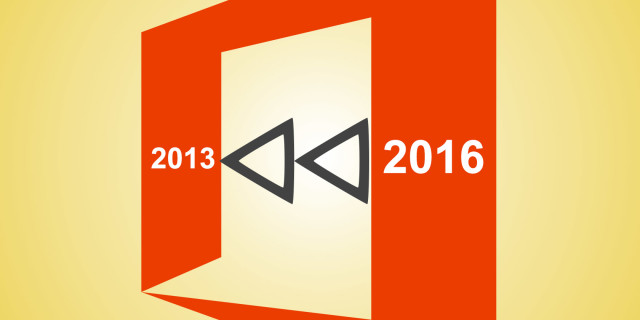

Office 2016 has been floating around for a few weeks now and many questions have accumulated.
Activation, licensing issues, version rollbacks, new features, standalone or 365, subscription or retail, and what features you might actually need are all important questions. Sifting through the Internet can be a long process, and you might not find the answers to your questions.
That’s where we step in! Here is a jolly nice MakeUseOf Q&A, answering as many of your questions as possible, with a few tricks and tips thrown in. Here we go!
Your version of Office 2016 should be available for immediate download. Based upon your current subscription level, you’ll receive one of the many versions of Office 2016. According to Microsoft, your current version should automatically update, or you can attempt to manually update. Check out these Microsoft links for how to manually update Office 365:
The software in your Office suite will be determined by the version you have. Take a look at this table for a little more information on what to expect from your current Office 365 subscription, or what a new license will get you:

It is also worth noting that Office 365 subscribers are rewarded with 1TB storage per user, plus 60 Skype-minutes per month.
No, you don’t. You can purchase a retail version of Office 2016 from the Microsoft Store, or any number of software retailers. It will come in one of the flavors noted above.
 Microsoft Office Home and Student 2016 | PC Key Card
Full, installed Office 2016 versions of Word, Excel, PowerPoint, and OneNote
Microsoft Office Home and Student 2016 | PC Key Card
Full, installed Office 2016 versions of Word, Excel, PowerPoint, and OneNoteAlmost. Microsoft offers a free online web-service, Office Online, which has been receiving updates over the past year. You don’t get the full-whack of a paid subscription or retail version, but it is still a robust Office suite, is free, is online, and is set to receive more feature updates in the near future.

As I said, it isn’t the full works. It is more comparable to an Office-lite version, or a restricted trial of Office 365. However you view it, Office Online has become an extremely viable alternative to previous king-of-the-online-office-suite-hill, Google Docs. Indeed, some would argue Office Online has surpassed Google Docs in recent times-but that is still very much up for debate.
The Office Insider program is a preview feature available to Office 365 Subscription holders, and to those who have already purchased a retail version of Office 2016. It works similarly to the Windows 10 Insider Preview program. You’ll receive early access to new features, and a chance to offer your opinion on how Office is shaped moving forwards. You can read more just here.
Yes, you can downgrade. We have previously covered the process of how to downgrade to Office 2013, so I won’t elaborate too much.

Briefly, if you’ve already upgraded to Office 2016, you’ll have to uninstall before reverting back. You’ll then have to download Microsoft Office 2013 through your Office 365 account, or locate your install material and key. For detailed information on downloading Microsoft Office 2013 through your Office 365 account read the above article.
Microsoft has also provided a useful document detailing the installation and use of different versions of Microsoft Office on a single PC. You will find instructions for Office 2016 and Office 2013, Office 2010, Office 2007, and Office 2003.
Unlike previous iterations of Microsoft Office, you can no longer install single applications to your system. Microsoft believes “the vast majority of customers prefer the full installation of all of the Office apps,” and as such have removed this feature. As the scale and style the Microsoft Office installation have also changed, this isn’t as much as an issue in previous years. There are less files to install, and those installed take up less room.
That said, as with Windows 10, some users resent the denial of choice in a product they are paying for. Sure, some people just want to click through things, but why should advanced users continually suffer for those who don’t want to learn?
Office 2016 has adopted the somewhat overbearing update system now synonymous with Windows 10. This auto-update system will feature two update branches that determine the speed at which you receive your updates. Just as with Windows 10, failure to update your software will result in a severance of security, both in terms of patches and feature updates. It is somewhat harsh, but this appears to be the Microsoft M.O for the time being.
Yes. Microsoft worked hard on bringing collaborative authoring to Office 2016, and it could be said it is about time. However, we understand why it hasn’t already appeared. Collaborative authoring wasn’t a feature of Office 2013, and it wasn’t in the plan to add this feature. Instead, Microsoft focused on delivering collaborative tools to Office 2016.
Oh, blimey. Depending on the severity of your bad times, it would be prudent to contact Microsoft Office Technical Support. You can start with support.office.com, and if you cannot find an answer there, you can contact the Microsoft Office Answer Desk for live support.
Microsoft would like to believe their latest iteration of Office allows its users to continue their work flow from one device to the next. I’ve largely found this to be true, switching from Office 2016 on Windows 10, to the Microsoft Word app for Android, and back again, finding my work intact, formatting preserved, with an intuitive experience to boot.
Office 2016 has made many fans, and the major upgrade to the Microsoft Office suite comes at a time where Redmond is riding high. Matching the Windows 10 operating system, Office 2016 can easily tie desktops, tablets, notebooks, and phones together in a seamless Office experience.
Collaboration is one of the major draws of Office 2016, as is the increased integration throughout the entire Microsoft ecosystem of apps, as well as new cloud-based features, but it still has many people asking “just why should I upgrade at all?”
And while there are numerous free alternatives — even Office Online — Office 2016 remains the real-deal, still top of the Office suite pile.
Will you be upgrading to Office 2016? Or do you use a free alternative? Let us know below!




 Metal Gear Solid V: The Phantom Pain - Achievements and Trophies List
Metal Gear Solid V: The Phantom Pain - Achievements and Trophies List How to get Teenage Mutant Ninja Turtles: Danger of the Ooze Achievements, Trophies for PS3 and Xbox 360
How to get Teenage Mutant Ninja Turtles: Danger of the Ooze Achievements, Trophies for PS3 and Xbox 360 Call of Duty: Advanced Warfare Reckoning DLC Unlockables and Easter Eggs
Call of Duty: Advanced Warfare Reckoning DLC Unlockables and Easter Eggs Ed Sheeran surprises couple on their wedding party and play Thinking Out Loud
Ed Sheeran surprises couple on their wedding party and play Thinking Out Loud How to Create Super Smash Bros. Characters for 3DS and Nintendo Wii U
How to Create Super Smash Bros. Characters for 3DS and Nintendo Wii U